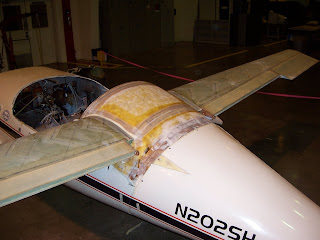When we had my plane flipped over, C-Rod came over and remarked that I was probably getting a lot of drag from the underside of the wheel pant, and when you look at it, I'm sure he is right.

This was the only time I could do anything about it, so we I dug in. I figured I could make some kind of cover, but the trick would be holding it in place. I finally decided to put slot in the wheel pant to hold the aft end of the skirt, then I would use a single fastener for the front.
First, I make a crude template from stiff paper. Then I made up a couple of flay lay-ups using two layers of carbon fiber.

The slot was cut into the pant and I stuffed flox into it to stiffen it up. While the flox was still wet, I stuck in a piece of aluminum covered with clear tape (black arrow). That would form the slit in the slot.

I needed a way to stiffen the skirts, so I made some vertical stiffeners by laying up strips on the inside of the wheel pant. This would get me a general shape. The stiffeners were attached to the skirt, in situ, then finally the front attach point was added.

My thoughts are to use the skirts only while racing and to be able to remove them without having to jack up the plane. However, I will probably have to jack up the plane to insert them.

I hope this gains me a knot or two.
























